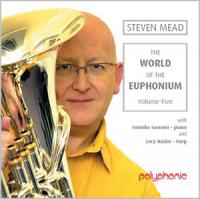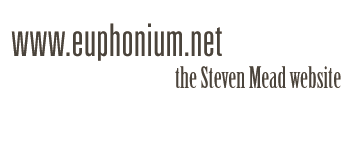World of the Euphonium Vol. 5 Review by Peter Bale
The core of Steven Mead's third volume under the heading "Euphonium Magic" is made up of original works for the instrument - or rather, for various numbers of euphoniums and/or tubas - with the title track, "Earth Voices" intended to be thought-provoking as well as of musical interest.
As before, one cannot help but admire the dedication - and the amount of studio time - involved in producing such a volume, and on the whole the combination of multiple Steven Meads works pretty well, with variations of attack and style ensuring that, whilst the voices naturally blend together, the texture never becomes bland or opaque.
The opening piece, "Rush Hour" by the young American composer Ben McMillan, has a jazzy feel, with motor horn effects and interjections that sound like trumpets rather than euphoniums, all working together to depict the hustle and bustle of urban living. Scored for eight euphoniums, the music is constantly on the move, with a triplet figure at one point reminiscent of "When you're a Jet" from "West Side Story", which may or may not be intentional.
Girolamo Frescobaldi was one of the most important composers in the development of keyboard music in 17th century Italy, and the "Toccata", in an arrangement for six euphoniums by Joe Skillen, offers the opportunity for slow, sustained playing in the opening section, with organ-like sonorities. There is some finely balanced playing in the livelier passages, with the parts often playing in thirds or sixths, and occasionally in canon. The liberal use of rubato is very effective, and must have involved tremendous concentration when recording the various parts.
Gail Robertson, euphonium player with both the Brass Band of Central Florida and also alongside Steven in the Brass Band of Battle Creek, has produced a gem in her "Eupher's Dream", for eight part euphonium choir. Opening with flowing lines and warm harmonies, but with the odd quirky rhythm to avoid both players and listeners getting too comfortable, it then moves into a lilting 6/8 passage, again with the odd quaver missing from the rhythmic patterns, and with duplets set against the quavers and semiquavers of the basic metre. Runs and roulades appear in various parts, but are always subservient to the main themes, and there are some telling bell effects.
Giovanni Gabrieli, working in Venice in the 16th and early years of the 17th centuries, made much use of the spatial possibilities of the churches where his music was to be played, and would often set choirs of various instruments in juxtaposition one with another. Steven performs his "Canzon XVII", written in twelve parts and published posthumously in 1615, and although all the instruments are the same, the antiphonal effects can still be heard plainly.
Steven takes a fluid approach to the changing rhythmic patterns in a reading that sounds quite natural and unforced. This is one of four arrangements by American Pat Stuckemeyer, who has already produced a couple of fine solo recordings, and is currently studying at the Royal Northern College of Music.
The various tuba and euphonium conferences held in recent years have often been the catalyst for new compositions and arrangements, and have frequently included the opportunity for a mass blow, to encompass players of varying standards. Maurice Bale arranged the "Soldiers' Chorus" from Gounod's "Faust" for the British conference a few years ago.
The Russian pianist and composer Alexander Goedicke wrote his "Concert Etude Op 49" for trumpet and orchestra, although it has been taken up by players of other brass instruments. In Pat Stuckemeyer's version for six euphoniums it loses nothing of the drive and verve of the original, whilst there is some tricky - and high - writing in the accompanying parts as well. The central melody is given due breadth and gravitas, and the almost throwaway ending is brought off neatly.
John Stevens' "Dances", written for solo tuba and accompanying trio, adapts well for four euphoniums, and is marked by excellent control and restraint on behalf of the soloist. With a central "Adagio" framed by two "Allegro" movements, there is much opportunity for interplay between soloist and accompaniment, particularly in the skittish finale, with the feel of an Irish jig, but jumping the occasional beat, giving it an edginess and ensuring the constant forward momentum is maintained.
David Holsinger is a prominent composer and arranger in the American wind band world, with a number of his works taking a religious theme as their basis. "On a Hymnsong of Philip Bliss" is based around the hymn "It is Well with my Soul", written following the tragic loss at sea of the writer's family. After an extended introduction, the soloist plays the first half of the melody in the upper register, before dropping the octave for the second half. The central section builds in intensity to match the words, with short descending semiquaver runs in various parts, before ending in quiet serenity.
Peter Meechan contributed a couple of items to Steven Mead's earlier Mozart celebration, "Brassin' Mozart", but "Funk Theory", for euphonium and trombone quartet, was actually commissioned by David Childs in 2003, being premiered by David and the all-female quartet Bones Apart. The accompanying parts transfer well to euphonium, although the bottom part in particular betrays its trombone origins. Somewhat of a departure in style from what one is accustomed to hearing from Steven, the solo part maintains an improvisatory feel against the backing rhythms laid down.
Italian euphonium player Gianni Banneta wrote the brief "Cartoon Symphony" when he was participating in a course run by Steven in Trento. Including such familiar themes as "The Flintstones", "Chopsticks", "The Simpsons", "Pink Panther" and "Merrie Melodies", and scored in six parts, the playing captures well the sense of fun that such cartoons have brought to generations. In total contrast, Gail Robertson's four-part setting of the theme from "Schindler's List" aptly catches the poignancy of John Williams' music, although in this instance the textures do seem a little muddy in places.
Hungarian tuba virtuoso Roland Szentpali scored his "Earth Voices" for eight part low brass ensemble, soloist and narrator. Based on an original Hungarian poem, the text, declaimed clearly and vividly by Steven himself - who else? - tells of the destruction of the earth's beauty, and is likely to strike a chord with many in these days of heightened interest in environmental issues.
No doubt individual reactions to this item will vary greatly, and some may find its sentiments somewhat trite or banal, but it does give rise to a wide range of music to illustrate the text, from the downright sinister, complete with menacing glissandi, to the idyllic, all conveyed seamlessly by Steven in multiple guises.
The disc is rounded off with a quick dash through Smetana's "Dance of the Comedians", from his opera "The Bartered Bride", the sleeve notes pointing out that this was the final item recorded, with the session lasting from 1 to 3am! Be that as it may, there are no signs of tiredness and this exhilarating romp proves a fitting conclusion to a very mixed programme.
The sleeve notes - uncredited, but presumably by Steven himself - give useful background on the music, and the disc is attractively packaged in Bocchino's distinctive cardboard gatefold style, with a particularly striking image of Steven flying through the sky on his euphonium. Recorded over three days in February 2007, but no doubt requiring many more hours of studio time to produce the final version, this is another fine offering from a master of his craft.
Peter Bale

Label: Polyphonic Reproduction
Steven Mead (euphonium) Tomoko Sawano (piano), Lucy Haslar (harp)
BUY NOW: http://www.euphoniumstore.net/store/product=13/

